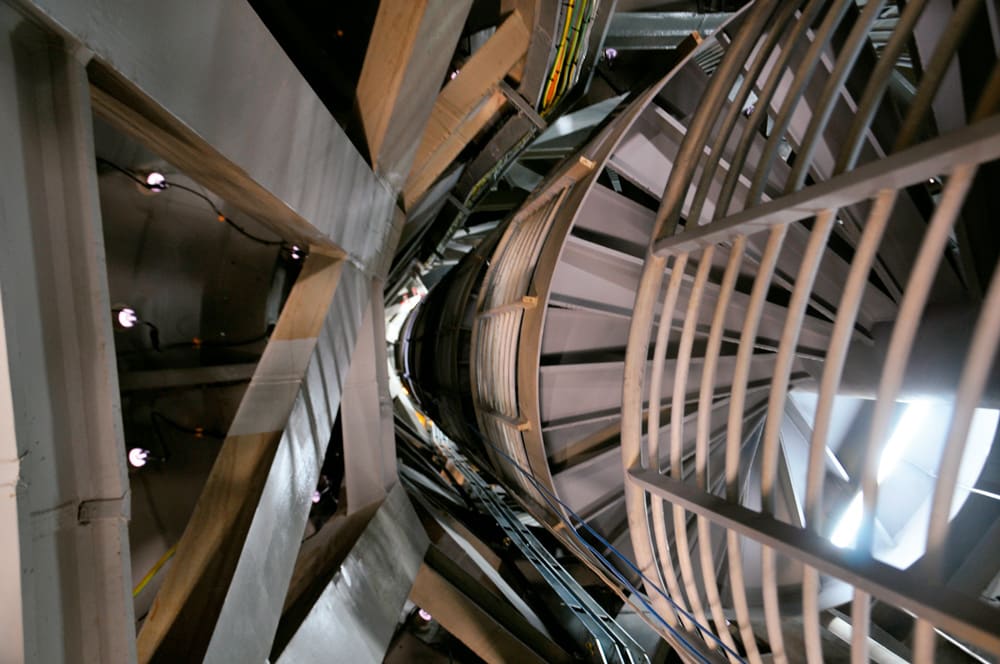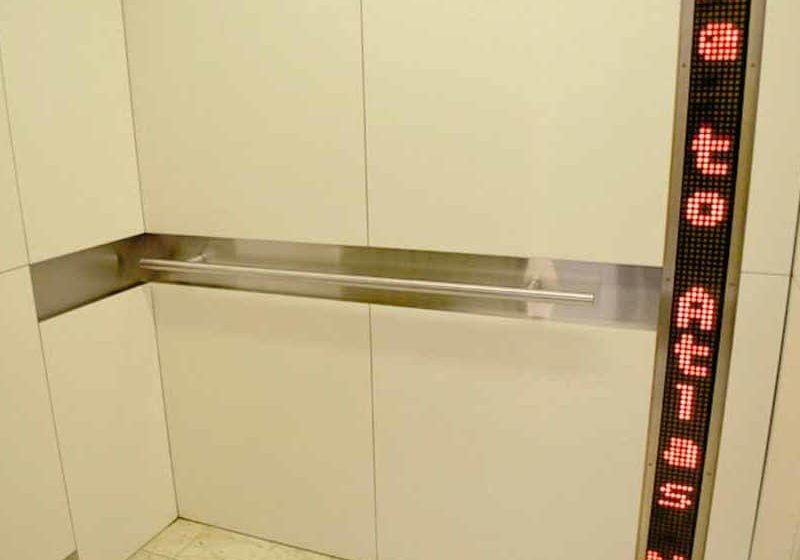Makkah Clock Tower Chairlift Project, Mecca, Saudi Arabia
Jan 1, 2014

submitted by Dr. Peter Klaus Kirner, ThyssenKrupp Access Solutions GmbH
photos courtesy of SL Rasch, ThyssenKrupp Access and Beyt Almeraj
In 2012, ThyssenKrupp Access Solutions GmbH installed what is probably the highest chairlift in the world. The “Flow” was considered the only possible chairlift solution due to its patented Advanced Swivel and Leveling (ASL) technology. The King Abdul Aziz Endowment Project is a building complex in Mecca, Saudi Arabia. It is located only meters away from the Holy Mosque, which surrounds one of Islam’s most sacred sites, the Kaaba. The most eye-catching building of the endowment project is the famous Makkah Clock Tower, which became the second-tallest building in the world in 2012 with a total height of 607 m.
To make the highest point of the clock tower – the crescent (Hilal) – accessible in a safe and comfortable way, ThyssenKrupp Access designed a tailor-made chairlift solution. Starting from the Mabkhara level on the top floor of the building at a height of 569 m, the Flow overcomes a further 18.4 m in height to reach the Hilal, which marks the summit of the impressive skyscraper. It is also credited as enabling this area to be the highest usable space inside any building.
The Flow is not only unique as regards its installation height, but also concerning its technical parameters. The staircase in the tower’s spire comprises seven spiral staircases with a total of 91 steps and an average tread width of only 380 mm. The rail of the chairlift was customized to fit into these extremely steep and narrow surroundings. It consists of 13 rail parts with 29 curves, adding up to a complete rail length of 24.8 m. The rail was installed on the inner curve of the staircase to minimize the space used on the stairway. The chairlift’s ASL technology synchronizes the drive unit of the chairlift with the geometry of the rail, thereby ensuring the seat is directed through the stairwell by making maximum use of the limited space available.
Measurement Survey
One of the greatest challenges in the course of this project was the measurement survey of the spiral staircase in the spire. Because each Flow chairlift is custom, accurate measurements are crucial for production of its rail. Under normal conditions, ThyssenKrupp Access would always measure a customer’s staircase by means of a photogrammetric measurement system. In this special case, however, such was not possible. At the time of the survey, neither the crescent on top of the building, nor the claddings around the spire had been installed.
In fact, the spiral staircase to be measured was the highest point of the building, with the last step of the staircase leading to nowhere. Measurement of the entire seven-spiral staircase had to be performed by hand. Performing this in open air with strong winds at a height of 569 m made it a major challenge. ThyssenKrupp Access sent a specially trained technician from its production facilities in the Netherlands who was not afraid of heights and – even more importantly – was a Muslim and, therefore, allowed to enter Mecca. Together with local distributor Beyt Almeraj, he carried out the survey. Despite several safety interruptions because of too-strong winds, he was able to produce an accurate measurement that would allow for first-time-right production and installation.
Engineering and Production
The optimal rail trajectory had to be designed based on the geometric data of the clock tower’s staircase. To use as little space of the stairwell as possible, it was decided to place the rail on the inside of the stair, while using chamfered bends that allow the rail to be mounted tight against the steps and inner column. This made installation less obtrusive, while the staircase remained accessible beside the rail. The result was a complex rail system with a total length of 24,753 mm comprising 29 curves. For production and installation purposes, the system was divided into 13 rail sections. Based on the engineering data, 13 steel tubes were cut to length and bent to the designed geometry.
At the same time, rack strips were cut and bent to the same length and shape as the tubes. The rack strips were welded to the tubes with the help of welding robots equipped with nine-axis manipulators. After fixation of the charging contacts and mounting brackets, the rails were powder coated. After the obligatory quality inspection, the completed rail system was ready to be shipped to Mecca, together with the chairlift drive unit.
ASL Features
ASL synchronizes the drive unit of the chairlift with the geometry of the rail, thereby ensuring that the seat is directed through the stairwell by making maximum use of the limited available space. The swivel-seat motor rotates the chair in the optimal and safest position, avoiding any obstacles during the ride. At the same time, the leveling motor ensures that the chair always stays horizontal during the ride with the help of gyro and inclination sensors. Both processes are carried out while the lift is moving and without the user taking notice. Without such technology as ASL, a chairlift could not have been installed on such a narrow spiral staircase.
Installation
For the Flow’s installation, the complete rail system had to be assembled and wired within the limited space available in the spiral stairwell. Hereafter, the rail was calibrated and welded to the structure of the stair. After a week of hard work, the drive unit and seat could finally be placed on the rail, completing the installation. After all quality inspections and a successful test ride, the Makkah Clock Tower’s Flow was finally handed over to the satisfied customer.
Credits
- Developer and contractor: Saudi Binladin Group
- Architect for clock, spire and Hilal: SL Rasch GmbH Special & Lightweight Structures
- Chairlift installer and photography: Beyt Almeraj Est.
Technical Parameters
- Staircase: 7 spirals, 91 steps
- tread width: 380 mm
- Travel height: 18,370 mm
- Rail length: 24,753 mm
- Curves: 29
- Rail parts: 13
- Speed: 0.15 mps
Special Features
- ASL technology
- Monorail system
- Foldable armrests
- Height-adjustable seat and footrest
Get more of Elevator World. Sign up for our free e-newsletter.









